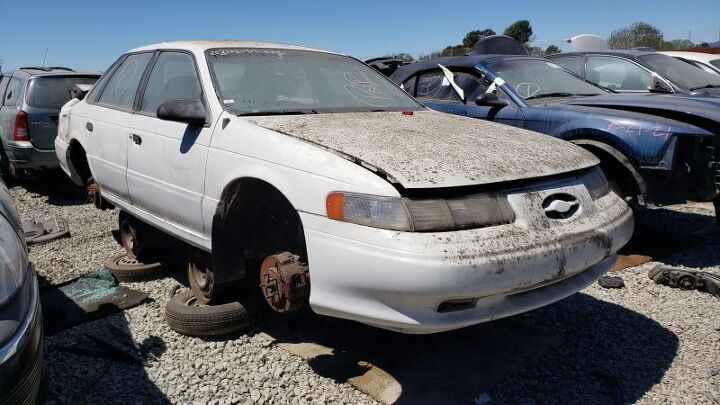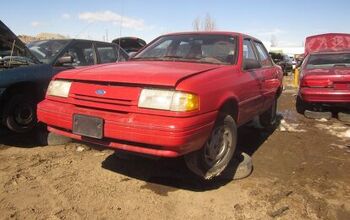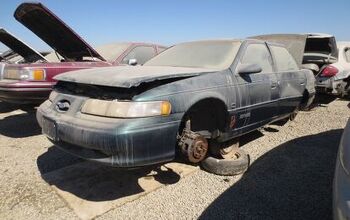Junkyard Find: 1992 Ford Taurus SHO

Ford introduced the high-performance version of the Taurus sedan— the SHO— in the 1989 model year, and enthusiasts rejoiced over the cheap new factory hot rod that blew away far more expensive European sedans. I’ve documented quite a few discarded SHOs during my junkyard travels, but this is the first ’92 I’ve photographed. Why is 1992 special for the SHO? Simple: It’s the final year for the mandatory five-speed manual transmission. Here’s one of those rare cars in a San Francisco Bay Area self-service yard.
Yamaha had been building organs and pianos for nearly a century when Ford hired the company to design a hot-rod version of the ho-hum Vulcan pushrod V6, though of course it was the screaming two-wheelers bearing the tuning-fork logo that interested Dearborn. Finally, an engine with a cooler-looking intake manifold than the Porsche 928, and 220 horsepower plus a 7,000-rpm redline from a naturally-aspirated 3.0-liter V6 was very impressive by the standards of the time (the 1989 Alfa Romeo Milano Verde’s 3.0-liter V6 made just 183 horses, though its exhaust note made all other V6s sound like ailing bovines).
By the time this car was built, the wearers of green eyeshades in the Ford Empire saw that many dollars were being left on the table due to the lack of an automatic transmission in the SHO. The Great Slushboxification of the American Road had been well underway for decades, and many American car shoppers absolutely refused to consider any car with three pedals. Something had to be done, and it was: for 1993, the Taurus SHO could be bought with an optional four-speed automatic coupled to an engine bored out to 3.2 liters (and tuned to make the same 220 horsepower as the 3.0 but with 15 extra pound-feet of torque).
The manual transmission remained available in the SHO through 1995; the 1996-1999 SHO had both a V8 engine and an automatic-only configuration and the 2010-2019 SHO epilogue had a twin-turbo V6 and six-speed automatic.
There had been a facelift for 1992, corresponding to the Mercury Sable‘s redesign (the 1989-1995 SHO used Sable front body parts), but the real change in SHO philosophy happened for the 1996 model year, when the car got softer and generally more about luxury than shredding tires.
In the early years of the 24 Hours of Lemons, we learned that the 1989-1995 Taurus SHO is a very quick car on a road-course race track ( in stark contrast to the 1996-1999 SHO).
We also learned that the SHO V6 tends to explode in spectacular fashion when road-raced, and that SHO transaxles disintegrate more spectacularly— and more frequently— than any other gearbox in 24 Hours of Lemons history. Did I mention the constant failures of SHO hubs and axles on the track?
Either due to the word about the SHO’s racing blow-uppityness spreading or the fact that Lemons racers used up just about every junkyard engine and transmission on the continent, we don’t see many of these cars on Lemons tracks today.
Factory CD players were still considered high-end luxury items in 1992 cars, subject to constant theft danger on the street. This single-disc player with “Premium Sound” speakers added 502 bucks to the car’s $23,889 price tag (that’s about $997 on a $47,450 car in 2021 dollars), and it didn’t sound anywhere near as good as the audio rigs that come as standard equipment in the most miserable econoboxes today.
Rewards the driver like no other performance sedan (although the Dodge Spirit R/T had a higher top speed).
No Spirit R/T could have done this, though. In fact, the only Spirit R/T to have entered a Lemons race never managed to turn a single official lap.
For links to better than 2,100 additional Junkyard Finds, please get towed into The Junkyard Home of the Murilee Martin Lifestyle Brand™.

Murilee Martin is the pen name of Phil Greden, a writer who has lived in Minnesota, California, Georgia and (now) Colorado. He has toiled at copywriting, technical writing, junkmail writing, fiction writing and now automotive writing. He has owned many terrible vehicles and some good ones. He spends a great deal of time in self-service junkyards. These days, he writes for publications including Autoweek, Autoblog, Hagerty, The Truth About Cars and Capital One.
More by Murilee Martin
Latest Car Reviews
Read moreLatest Product Reviews
Read moreRecent Comments
- HotRod Not me personally, but yes - lower prices will dramatically increase the EV's appeal.
- Slavuta "the price isn’t terrible by current EV standards, starting at $47,200"Not terrible for a new Toyota model. But for a Vietnamese no-name, this is terrible.
- Slavuta This is catch22 for me. I would take RAV4 for the powertrain alone. And I wouldn't take it for the same thing. Engines have history of issues and transmission shifts like glass. So, the advantage over hard-working 1.5 is lost.My answer is simple - CX5. This is Japan built, excellent car which has only one shortage - the trunk space.
- Slavuta "Toyota engineers have told us that they intentionally build their powertrains with longevity in mind"Engine is exactly the area where Toyota 4cyl engines had big issues even recently. There was no longevity of any kind. They didn't break, they just consumed so much oil that it was like fueling gasoline and feeding oil every time
- Wjtinfwb Very fortunate so far; the fleet ranges from 2002 to 2023, the most expensive car to maintain we have is our 2020 Acura MDX. One significant issue was taken care of under warranty, otherwise, 6 oil changes at the Acura dealer at $89.95 for full-synthetic and a new set of Michelin Defenders and 4-wheel alignment for 1300. No complaints. a '16 Subaru Crosstrek and '16 Focus ST have each required a new battery, the Ford's was covered under warranty, Subaru's was just under $200. 2 sets of tires on the Focus, 1 set on the Subie. That's it. The Focus has 80k on it and gets synthetic ever 5k at about $90, the Crosstrek is almost identical except I'll run it to 7500 since it's not turbocharged. My '02 V10 Excursion gets one oil change a year, I do it myself for about $30 bucks with Synthetic oil and Motorcraft filter from Wal-Mart for less than $40 bucks. Otherwise it asks for nothing and never has. My new Bronco is still under warranty and has no issues. The local Ford dealer sucks so I do it myself. 6 qts. of full syn, a Motorcraft cartridge filter from Amazon. Total cost about $55 bucks. Takes me 45 minutes. All in I spend about $400/yr. maintaining cars not including tires. The Excursion will likely need some front end work this year, I've set aside a thousand bucks for that. A lot less expensive than when our fleet was smaller but all German.




















































Comments
Join the conversation
I remember when these were introduced, Ford dealers had no idea what to do with them. A local Jacksonville FL dealer, King's Crown Ford had 5-6 in stock, mostly black on tan but one particularly sharp silver with I believe black interior. I was wheeling a Mustang GT convertible and thought a sedan would serve me better as a car used for both work and pleasure. Several test drives later I ended up in the salesman's cube getting the screws turned on me. First they added a $1500 "market adjustment" based on limited production and demand... what? You have 6 of them, not paying it. Then they lowballed my Mustang, a near perfect '88, 5 speed, dark red over white top and interior. They insisted "nobody wants a convertible anymore". The result was they wanted my Mustang and 12k for the leftover '89 SHO. After wasting 3 hours at this dingy dealership i grabbed the keys to my 5.0, put the top down and left the parking lot in a cloud of expensive Goodyear Gatorback tire smoke. The salesman called me the next day repeatedly at work trying to get me back but never would agree to my number, which was 9k and my GT. The Mustang was stolen from my apartment complex about a year later, I thought about replacing it with the SHO but settled for a clean, low mile Celebrity Eurosport V6. I frequently regret not finding a more reasonable dealer especially when the updated '92s came out but by then I was married, had a mortgage and settled for another used GM workhorse in the guise of a '91 Bonneville LE. Once Ford bolted an automatic to that glorious V6 I felt they'd sold out and I lost interest. The later versions did nothing to change that opinion. Now I'm waiting for a build date on my manual, Sasquatch Bronco and hope I'm not disappointed again.
You forgot to mention that our 89 SHO was the first Lemons winner to be driven to the track. MSRH February 2010. The car is still raced once or twice a year.